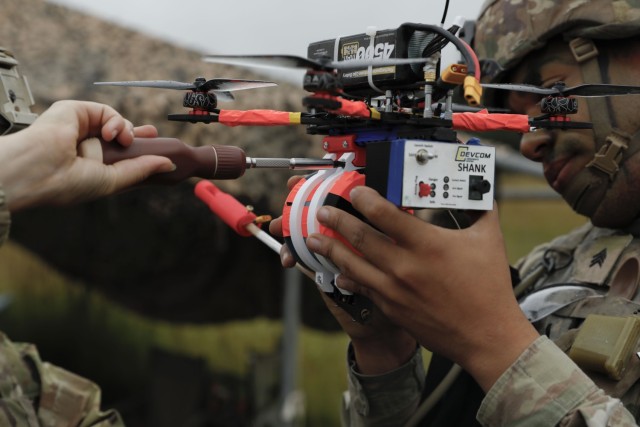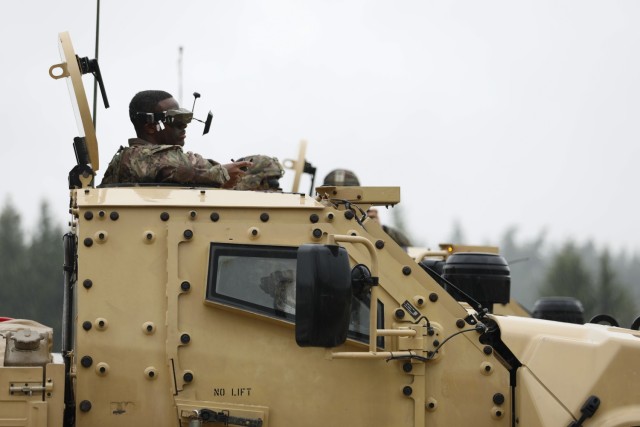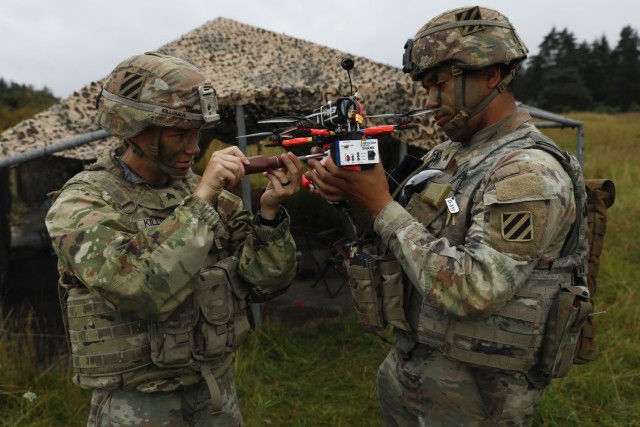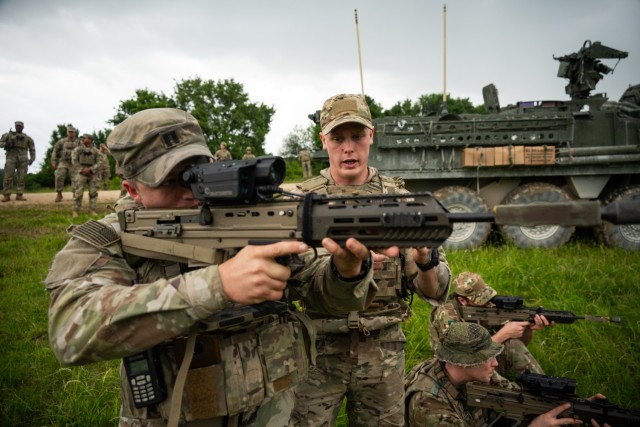
U.S. Army Sgt. Elena Killough and Sgt. Demond Blach, assigned to the Deathwatch Platoon, 10th Brigade Engineer Battalion, 1st Armored Brigade Combat Team, 3rd Infantry Division, prepare an Unmanned Aircraft System during a first person view individual qualification on Grafenwöhr Training Area, July 21, 2025. The 1st ABCT, 3rd Infantry Division, tests purpose-built, retrievable FPV drones to highlight the ability against autonomous targets to improve battlefield readiness and integration with armored units. The 1st Infantry Division and V Corps are part of America’s Forward Deployed Corps in Europe which works alongside NATO Allies and regional security partners to provide combat-ready forces, execute joint and multinational training exercises, and retain command and assigned units in the European Theater. (U.S. Army photo by Spc. Josefina Garcia)
VIEW ORIGINAL
WASHINGTON – Army leaders from V Corps, headquartered in Fort Knox, Kentucky, spoke of lessons learned and the importance of Project Flytrap as part of the Army’s Transformation Initiative during a media round table July 30, 2025.
“[Counter-unmanned aerial systems] are essential to success on the modern battlefield,” said Lt. Gen. Charles Costanza, commanding general of V Corps. “U.S. and allied forces must rapidly transform to the very real threat of unmanned drones by testing, adjusting, and ultimately integrating the best C-UAS platforms in the world to protect our forces. Project Flytrap is a key component of V Corps’ transformation strategy.”
Project Flytrap 4.0 runs from July 27-31, at Bemowo Piskie Training Area (BPTA), near Elk, Poland. It is the final iteration of the C-UAS training events where Soldiers from the 2nd Cavalry Regiment and 1st Royal Yorkshire Regiment, United Kingdom test new counter-UAS capabilities in combined exercises meant to develop and inform the future of anti-drone tactics and technologies.
Results from Project Flytrap will inform the way the U.S., Allies and partners fight on the modern battlefield, said Col. Donald Neal, Jr., regimental commander, 2nd Calvary Regiment, Grafenwoehr, Germany.
“Developing, testing, and fielding C-UAS technologies together with our NATO Allies and partners enhances our deterrence capability,” he said. “Training and experimentation with our Allies and partners serve to build capacity and increase European leadership in European security, effectively strengthening the NATO Alliance.”
We’re uniquely positioned in Europe, where we can work with Allies and partners to provide opportunities for innovation with the latest emerging technology and capabilities, said Col. Matt Davis, transformation chief and exercise director of V Corps, Project Flytrap. “Project Flytrap is one of those. It’s a series of training events we’ve designed to test and refine new counter-unmanned aerial systems, technologies and tactics to respond to the evolving threat of drone warfare.”
Project Flytrap sits at the intersection of Army transformation and modernization efforts that will change the way it plans, operates and fights in large-scale combat operations, Neal said.
“These efforts enable increased lethality for our forces, improved and expanded the capabilities of our Allies and partners, and provide credible deterrence to any adversary that would think to test us,” Neal said.
More than 40 organizations, 400 representatives across industries, and Allies and partners from four different countries including UK, Poland, and Australia, participated.
Iterations
The first phase of Project Flytrap began in March and was launched to identify and test counter UAS solutions. This meant research and fact-finding from historical data and lessons learned from the war in Ukraine. The second phase included installing these systems into various platforms within the U.S. and UK’s formations.

A U.S. Army Soldier assigned to the Deathwatch Platoon, 10th Brigade Engineer Battalion, 1st Armored Brigade Combat Team, 3rd Infantry Division, operates a first person view drone on a Joint Light Tactical Vehicle (JLTV) during individual qualification on Grafenwöhr Training Area, July 21, 2025. The 1st ABCT, 3rd Infantry Division, tests purpose-built, retrievable FPV drones to highlight the ability against autonomous targets to improve battlefield readiness and integration with armored units. The 1st ABCT, 3rd Infantry Division, and V Corps are part of America’s Forward Deployed Corps in Europe which works alongside NATO Allies and regional security partners to provide combat-ready forces, execute joint and multinational training exercises, and retain command and assigned units in the European Theater. (US Army Photo by Spc. Josefina Garcia)
VIEW ORIGINAL
Through theory and trial and error, feedback from the Soldiers who were manning and using these systems ensured that efficacy was at the forefront of further developmental decisions resulting in doctrinal squad size and standardized equipment, said Neal.
The third phase focused on conducting squad and platoon-level counter-UAS exercises. Theories and best practices were further developed through real-world data, creating a solid foundation for the implementation of C-UAS squads across the Army. These training exercises were limited in scope to ensure maximum control for data gathering. The last iteration concluded July 31 and implemented battalion-level operations, with defensive and offensive operations around the clock without interruption.
“This pushed the realism factor even higher to maximize the quality of training and feedback,” said Command Sgt. Maj. Eric Bol, command sergeant major, 3rd Squadron, 2nd Cavalry Regiment.
Training
Infantry Soldiers took eight-hour courses over three days next to industry experts, learning to build almost 300 UASs with about a dozen models and how to counter them in the field, Bol said.
“We made sure those models represented each kind of capability you’d expect to see on the modern battlefield,” Davis said. “Some have thermal optics for nighttime. We used fiber optic drones, jam-resistant, we had larger drones like octocopters. We had six-winged. We really went through a lot of effort to diversify the threat.”

U.S. Army Sgt. Elena Killough and Sgt. Demond Blach, assigned to the Deathwatch Platoon, 10th Brigade Engineer Battalion, 1st Armored Brigade Combat Team, 3rd Infantry Division, conduct maintenance on an Unmanned Aircraft System during a first person view individual qualification on Grafenwöhr Training Area, July 21, 2025. The 1st ABCT, 3rd Infantry Division, tests purpose-built, retrievable FPV drones to highlight the ability against autonomous targets to improve battlefield readiness and integration with armored units. The 1st ABCT, 3rd Infantry Division, and V Corps are part of America’s Forward Deployed Corps in Europe which works alongside NATO Allies and regional security partners to provide combat-ready forces, execute joint and multinational training exercises, and retain command and assigned units in the European Theater. (U.S. Army photo by Spc. Josefina Garcia)
VIEW ORIGINAL
Although the Soldiers have an infantry military occupational specialty, they may have come from a science and math-focused education and have a hidden talent for building drones, said Madera.
“It’s looking past the MOS and finding their hidden talents and then employing them to help us make these changes at the unit level,” he said.
The unit has a drone production and training facility where they assemble the components, build them with 3D printers and learn to fly the drones.
“I don’t have a huge tech background. I’ve been amazed to see what this unit has been capable of,” Bol said. “I’ve watched Soldiers who have an aptitude dive into this and be extremely passionate about it. It’s fun to watch them learn how to build, break and rebuild the drones in the same facility. I have several peers across the Army, in different theaters, and we’re all learning how to fight with UASs, how to defend against them, and how to maintain them.”
We’re taking the latest, cutting-edge versions of existing technology like radar, RF detect and jam, optical and audio sensors, and then merging those into a system our Soldiers on the ground can employ in a tactical setting in order to enable them to do their jobs despite having its own threat, Bol said.
Industry partners went out in the field and worked side-by-side with the Soldiers, sometimes in inclement weather, to fix issues such as battery drainage and equipment compatibility across Allied platforms.
As combat and technology continues to evolve, Lt. Col. Jeremy Medaris, commander, 3rd Squadron, 2nd Calvary Regiment, said the Army is becoming more adaptable, mobile, lethal and more survivable.
As the Soldiers trained with the new technology, Medaris said the fundamentals of maneuver warfare still matter.
“Dispersion, protection, fortification, collecting the correct routes, planning to an objective, they remain essential,” he said. “The essential nature of warfare still matters. Some components are changing, but those fundamental pieces are still there and just as applicable to the counter-UAS fight as well.”
Layering
Each capability brought to combat has its strength and weakness, so having a layering of capabilities is important, said Davis.
“There’s no one system or one solution to counter-UAS,” Neal said. “The counter-UAS capability we’ll have in the future is going to have to be an integrated, multi-system solution.”
The layered effect during Flytrap included a Stryker infantry formation, Soldiers wearing technology with radio frequency detect and defeat capability to jam UAS’s, Soldiers with M-4s to shoot down enemy drones and Soldiers who were manning the drones from the other side, said Medaris.

U.S. Army Capt. David Smith, the “Lightning Troop” company commander of 3rd Squadron, 2nd Cavalry Regiment, tests the SMASH X4 attached to a British Armed Forces SA80A3 rifle during Project Flytrap at Joint Multinational Readiness Center, Hohenfels Training Area, Hohenfels, Germany, June 6, 2025. Project Flytrap is a series of CUAS training scenarios that test the capabilities of new, lower-cost and portable technology against adversary drone threats. (U.S. Army photo by Spc. Elijah Magaña)
VIEW ORIGINAL
Another layered consideration is active and passive. Active means a Soldier is emitting some type of signature, making them vulnerable on offensive operations. Passive has limitations but allows a Soldier to move on the offensive without giving their position away in the electromagnetic environment.
Yet another layer is deciding what to do, from the rifleman up to the three-star general, when systems detect potential enemy UAS systems in the air that may have potential intent.
“At each echelon, you need the ability to handle that type of data on the systems we use to communicate with,” Neal said. “You have two options: you have the ability to do assault kills, which means you’re altering the flight path without a projectile in the air that shoots it out of the air. Or a hard kill, which means you’re altering the flight path with projectiles. So, it’s neutralized or destroyed.”
Davis said using diversified drones helped with the layering effects.
“If we flew the fiber optics, the RF detect systems we were using, they weren’t going to detect them,” he said. “We had to rely on acoustics or an optical, for example.”
These layering effects and training scenarios learned throughout the five months of Project Flytrap will continue to inform the Army’s transformation in C-UAS capability.


